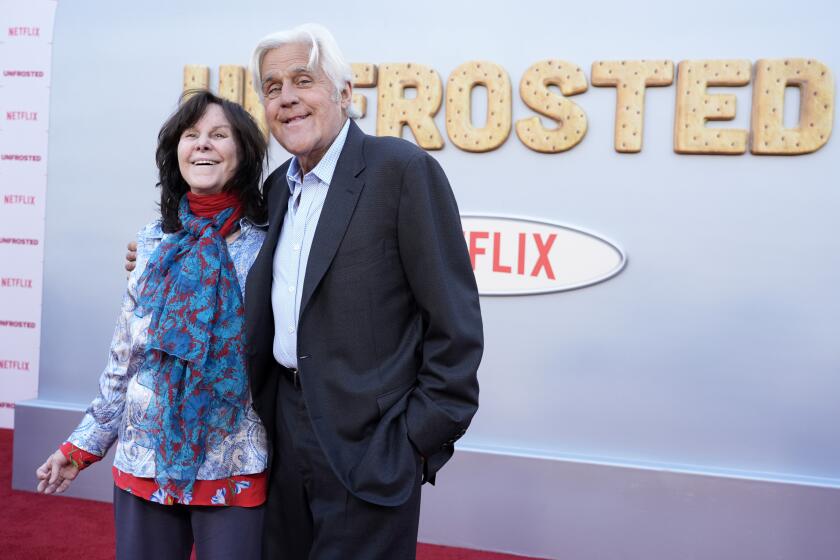DANCE REVIEW : Mark Morris Reaches Out to Mozart
- Share via
IRVINE — Skipping buoyantly for an instant, then walking prosaically, deep into his weight, Mark Morris piles up movement contrasts in a performance of his recent “Rondo” solo at the Irvine Barclay Theatre on Wednesday.
One moment he shows us the elegant stretched spine of a 19th-Century ballet prince; the next the loose, boneless slump of a contemporary contortionist. Always, however, his arms are animated by the Mozart accompaniment. Indeed, there are passages where he seems to literally reach out for the music as if it were hovering nearby and might be touched or even caught.
For the record:
12:00 a.m. Oct. 8, 1994 For the Record
Los Angeles Times Saturday October 8, 1994 Home Edition Calendar Part F Page 12 Column 6 Entertainment Desk 1 inches; 30 words Type of Material: Correction
Dance review-- Because of an editing error, Marianne Moore’s name was misspelled in a review Friday of the Mark Morris Dance Group at the Irvine Barclay Theatre. “Crown With Festal Pomp the Day” was also misspelled.
All of these quirky juxtapositions create the sense of infinite choices in dancing to Mozart, a summary of endless options. Music and the structures derived from it provide the only bedrock unity here, with matters of movement style, impetus and vocabulary completely up for grabs.
If the challenge of diversity looms large in American consciousness right now, you can find it embraced with fervor and restless invention in the Morris repertory. Moreover, working with his 15-member Dance Group, the 38-year-old dancer and choreographer achieves a feeling of creative freedom and spontaneity that his ballet-company commissions often lack. He’s looser, sharper and younger here: at home and among friends.
Besides “Rondo,” Morris brought to Irvine two new group pieces alike only in their bold authority and meticulous craftsmanship. Set to Ibert, “Lucky Charms” revels in parodistic razzmatazz, assembling every kind of parade, chorus-line and ballroom display in a deliriously splashy opening number to end all opening numbers.
Originally choreographed for the Zivili Slavic dance company, “The Office” is not a music visualization per se, but a dance drama (to Dvorak) in which a roomful of people are summoned, one by one, by a figure carrying a clipboard. They never return.
As each person departs, those remaining dance together, exploring their communal feelings in the brief period before the next individual is called. Their dances are varied but warmly expressive and often almost conversational in their ebb and flow.
You can interpret the situation in many ways (political interrogations? AIDS casualties?), but it’s the definition of community spirit that gives the work its poignance. In the same way, the depiction of group transcendence makes Morris’ familiar Vivaldi “Gloria” (1981, revised 1984) deeply stirring.
Initially we see people inching painfully forward on their bellies, but by the triumphant ending, they’re joyously body-surfing into the same position between star-burst leaps and other statements of liberation.
Equally memorable, perhaps: Craig Patterson’s remarkable anguish in the “Agnus Dei” section: a portrait of individual suffering set against chilling group indifference.
“Handel Choruses” from 1985 proves a lesser achievement and even arguably cheap in concept: a suite of solo dances that arbitrarily links four pieces of music that don’t belong together (the first three downbeat in subject, the last celebratory).
The performance isn’t persuasive either. Marianne Moor struggles with the balances in the inventive “All We Like Sheep.” June Omura has the technique but not the emotional power for “Jealousy” (originally danced by Morris himself).
Mireille Radwan-Dana urgently projects the mime imagery of “He Sent a Thick Darkness.” But Victoria Lundell can’t put across Morris’ perversely cutesie-poo physicalization of the mighty “Crown With Festa Pomp the Day” and ends up looking like a cheerleader for a losing team.
The single, sold-out performance was, ridiculously, Morris’ only Southern California appearance this season and was danced to tape. In contrast, Berkeley got Morris’ monumental full-length “L’Allegro, Il Penseroso ed il Moderato” with orchestra, chorus and vocal solos. Someone down here obviously isn’t in touch with what’s happening.
More to Read
The biggest entertainment stories
Get our big stories about Hollywood, film, television, music, arts, culture and more right in your inbox as soon as they publish.
You may occasionally receive promotional content from the Los Angeles Times.










